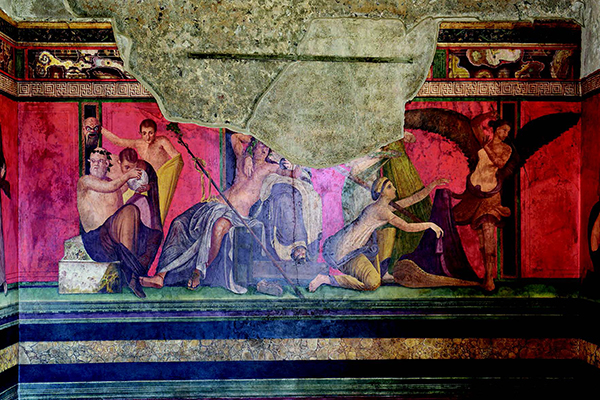La megalografia nella Villa dei Misteri a Pompei
DOI:
https://doi.org/10.15168/xy.v6i11-12.2524Abstract
La stanza del triclinio nella Villa dei Misteri in Pompei si caratterizza come un’enigmatica rappresentazione in un’ideale cornice architettonica. Nel ciclo pittorico, lo zoccolo a fondo nero, con ornamentazione geometrica, è il frutto di un restauro avvenuto all’epoca del III stile, mentre la parte alta delle pareti mostra l’originaria decorazione databile al II stile. Il ciclo pittorico è imperniato sull’evidente centralità della coppia Dioniso e Arianna; il riferimento a Dioniso è presente per l’iniziazione ai riti dionisiaci e Arianna è posta per evidenziare la preminenza della figura femminile. È singolare che molti secoli dopo, un trattatista del Cinquecento, Filarete, scriva che per realizzare una buona architettura o una città è necessario che ci sia una coppia: un padre, un principe illuminato, e una madre, l’architetto, che genera le idee del principe. La ricerca condotta presso la Villa dei Misteri è stata l’occasione per riflettere sul ruolo delle tecnologie che sono solo protesi del pensiero e del logos, generatrici del disegno dell’esistente o il disegno di ciò che non è stato ancora realizzato. Chiedersi nell’epoca che viviamo, connotata dall’utilizzo di tecnologie digitali avanzate nella formazione e nell’attività di ricerca degli architetti, dei designer, se sia possibile instaurare un nuovo paradigma che leghi l’osservatore all’oggetto, spesso orientato solo dalle librerie iconiche dei software, trova nell’esperienza condotta sulla Stanza dei Misteri, la riconferma dell’autorevolezza del pensiero che non può spezzare il legame imprescindibile che lega colui che disegna con l’oggetto. Come sappiamo i manufatti o il paesaggio sono muti: parlano attraverso chi osserva trasferendo alla mano la responsabilità di esprimere ciò che la mente genera.

##submission.downloads##
Pubblicato
Come citare
Fascicolo
Sezione
Licenza
Copyright (c) 2023 XY. Studi sulla rappresentazione dell’architettura e sull’uso dell’immagine nella scienza e nell’arte

Questo lavoro è fornito con la licenza Creative Commons Attribuzione - Non commerciale - Condividi allo stesso modo 4.0 Internazionale.

